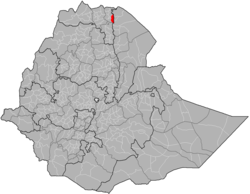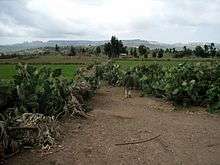Atsbi Wenberta
Atsbi Wemberta (Tigrinya: ኣጽቢ ወምበርታ) is one of the woredas in the Tigray Region of Ethiopia. Located in the Misraqawi Zone at the eastern edge of the Ethiopian highlands, Atsbi Wenberta is bordered on the south by the Debub Misraqawi (Southeastern) Zone, on the west by Kilte Awulaelo, on the north by Saesi Tsaedaemba, and on the east by the Afar Region. The administrative center of this woreda is Atsbi (officially Atsbi Endaselassie Ge'ez: ኣጽቢ እንዳስላሴ); other towns in Atsbi Wenberta include Haiqi Mesahil, Atsbi Dar'a, Kelisha Emni and Habes. The woreda is administratively divided into 18 tabiyas (municipalities).
Atsbi Wemberta ኣጽቢ ወምበርታ | |
|---|---|
 | |
 Flag | |
 | |
| Region | Tigray |
| Zone | Misraqawi (Eastern) |
| Area | |
| • Total | 1,758.11 km2 (678.81 sq mi) |
| Population (2007) | |
| • Total | 112,341 |
Overview

The elevation of this woreda varies from 918 to 3069 meters above sea level.[1] Rivers in Atsi Wenberta are seasonal and flow only during the rainy season. There is no lake but there are small streams and ponds. The soil is seriously degraded, and there is hardly any forest or woodland, with the notable exception of north Tigray's largest forest on the Rift Valley shoulder and on the escarpment towards the Danakil depression: the Des'a forest. Irrigation is used in the few places where it is possible; the suitable sites are rare. On many slopes the soil is so highly eroded that even when rain falls, it can retain only a small amount of moisture.[2] Nine of the 16 peasant associations in Atsbi Wenberta have an elevation of 2600 meters or higher, and are planted in barley, wheat, pulses like faba beans, and small ruminants like sheep are raised. The other seven peasant associations have an elevation below 2600 meters and are planted in teff, wheat, and barley, and both livestock and apiculture are cultivated; 6729 bee colonies are reported in this woreda. A major cash crop are faba beans, and Atsi Wenbarta is an important supplier of sheep and goats for meat to the nearby towns of Wukro, Adigrat, and the city of Mekelle.[1]
History
Ancient and Medieval period
Atsbi Wemberta was composed of four sub provinces mainly Dera, Atsbi, Dessia and Wemberta. There are Axumite and Pre Aksumite sites which return the Wereda's history back to antiquity. Habes, Era, Safir, Zerema, Keteba and Sekera were major Archaeological sites of the Wereda. Oral tradition indicate that Atsbi Wemberta was the birthplace of Queen Sophia, mother of Ezana and Sayzana. During the Aksumite Civilization several rock churches were built. Among them, the major architecturally fine churches are Mikael Debreselam, Mikael Amba, Zerema Georgis, Cherkos Agewo and Mikael Bark. There are also other dozens of ancient churches. In the dawn of 19th C, the town of Atsbi Endaselasie was established as a result of the church's foundation by Dejazimach Subagdis. Elders narrate that two Rases and 17 dejazmaches ruled Atsbi from the reign of Subagadis to the coming of Derg.
20th century
Historically, the district of Wemberta has been an integral part of Enderta province, when Enderta was an independent province as well as an awrajja as recent as the late 1990s [3][4]
Wemberta was occupied by the Ethiopian People's Revolutionary Party (EPRP) in 1978. Local shifta (or brigands) are said to have joined the EPRP and robbed woreda inhabitants, using the political organization as a cover. They killed at least one man known as Hagos Tesfu. However, when the EPRP left, the shifta remained in the area. The Derg then organized the local people against these shifta, which resulted with one killed, one fleeing to the Afar Depression, and four being executed. In 1980, the Tigrayan People's Liberation Front took control of the area, which resulted in numerous military campaigns by the Derg; woreda inhabitants were arrested or killed by the military, their livestock were killed and married women raped.[2]
21st century
Atsbi Wenberta was one of nine woredas in Tigray most affected by a drought during 2008, requiring emergency food supplies requested for an estimated 600,000 people.[5]
Culture
The culture and culinary of the woreda is heavily influenced by Enderta, Agame and Raya of the Tigrayans, and the Afars whereby it's the interface of the four local cultures. But, such culture is now declining because of youth migration and influence of other culture.
Dance
Any body who flew to Atsbi Wenberta, he/she definitely get astonished by the number of dancing styles available on the wereda like Hura-Seleste, Gumaye, Tegomtsets, Tilhit, etc. Among all here is the most exciting one and gained popularity in the neighboring woredas of Tigray and Afar regions, is Hura Seleste. They have songs related only to the Christmas.
Hura-Seleste evolves from the history of the relation between Atsbians and Axumite kingdom, in which “Royal Axumite Troops” have had guarded their national fervour. It is a type of dancing with an intricate foot work in which the entitled youngsters or men can play on a circular pattern after single Hura song.
Hura-Seleste is a dance with many steps; dancers pay due attention to hura hade, hura kilte, Hura-Seleste and hura Arbaete.
Food
Tihilo ጥሕሎ "ጥሕሎ ንልቢ የጥልሎ" , Gogo ወይ ሕምባሻ, Kitcha bMear, Siwa (beer) ዱቃ, and Mies ሜስየ ሜስየ ናይ ወልዱ እያ ናይ ሱባጋድስየ (Tejj Honey-wine) are the popular foods and drinks. The traditional dance of Hura-Seleste is colorful especially during the Ethiopian Christmas.
Clothes
Youths of Atsbi Wenberta make a special thin, decorated with evenly roasted stick called the Birbir.
Demographics
Based on the 2007 national census conducted by the Central Statistical Agency of Ethiopia (CSA), this woreda has a total population of 112,341, an increase of 85,561 over the 1994 census, of whom 53,659 are men and 58,682 women; 11,144 or 9.92% are urban inhabitants. With an area of 1,758.11 square kilometers, Atsbi Wonberta has a population density of 63.90, which is greater than the Zone average of 56.93 persons per square kilometer. A total of 26,425 households were counted in this woreda, resulting in an average of 4.25 persons to a household, and 25,533 housing units. The majority of the inhabitants said they practiced Ethiopian Orthodox Christianity, with 97.79% reporting that as their religion, while 2.12% of the population were Muslim.[6]
The 1994 national census reported a total population for this woreda of 93,659 of whom 45,521 were men and 48,138 were women; 32,229 or 34.41% of its population were urban dwellers. The three largest ethnic groups reported in Atsbi Wenberta were the Tigrayan (62.19%), the Amhara (33.91%), and the Oromo (2.24%); all other ethnic groups made up 1.66% of the population. Tigrinya is spoken as a first language by 61.36%, 36.48% Amharic, and 1.36% speak Oromiffa; the remaining 0.8% spoke all other primary languages reported. 78.35% of the population said they were Ethiopian Christians, and 21.45% were Muslim. Concerning education, 14.76% of the population were considered literate, which is greater than the Zone average of 9.01%; 20.65% of children aged 7–12 were in primary school, which is more than the Zone average of 11.34%; 3.09% of the children aged 13–14 were in junior secondary school, which is more than the Zone average of 0.65%; 3.38 of the inhabitants aged 15–18 were in senior secondary school. Concerning sanitary conditions, 91% of the urban houses and 43% of all houses had access to safe drinking water at the time of the census; about 12% of the urban and 31% of the total had toilet facilities.[7]
Economy
There are several local monolithic churches in this woreda, which include Mikael Barka, and Mikael Imba.[8] There are also several churches which were originally built in Aksumite times; these include Mikael Debre Selam and Zarema Giyorgis located northwest of Atsbi.[9] Other heritage rich churches and monasteries like Selassie Atsbi, Asira Metira and Mariam Dibo are available. Though the wereda is roch in tourism potential the destination is not well developed, tour guides are from Wukro. One micro-finance institution operates in Atsbi Wenberta, the Dedebit Credit and Saving Institution SC, with two sub-branches in Atsbi which report to the office in Wukro. There are 16 multipurpose cooperatives in this woreda, one for each kebele. However, these cooperatives have faced a number of problems, which include a failure to compete successfully with local private traders and the discovery after a 2004 audit of all of the cooperatives that 47,000 Birr was missing.[1]
Agriculture

A sample enumeration performed by the CSA in 2001 interviewed 21,729 farmers in this woreda, who held an average of 0.46 hectares of land. Of the 10,040 hectares of private land surveyed, 84.53% was under cultivation, 4.15% pasture, 3.95% fallow, 1.24% in woodland, and 6.11% was devoted to other uses. For the land under cultivation in this woreda, 69% was planted in cereals, 12.9% in pulses, 0.64% in oilseeds, and 2 hectares in vegetables. The total area planted in fruit trees was 186 hectares, while 1 hectare was planted in gesho. 74.65% of the farmers both raised crops and livestock, while 19.36% only grew crops and 5.99% only raised livestock. Land tenure in this woreda is distributed amongst 93.18% owning their land, 5.56% renting, and 1.28% holding their land under other forms of tenure.[10]
Reservoirs
In this district with rains that last only for a couple of months per year, reservoirs of different sizes allow harvesting runoff from the rainy season for further use in the dry season. The reservoirs of the district include
- Addi Shihu,
- Era, and
- Felaga.
Overall, these reservoirs suffer from rapid siltation.[11][12] Part of the water that could be used for irrigation is lost through seepage; the positive side-effect is that this contributes to groundwater recharge.[13]
Notes
- "Pilot Learning Weredas: Atsi Wenberta" Archived December 8, 2008, at the Wayback Machine (October 2004), IPMS Information Resources Portal - Ethiopia, pp. 5-16. (accessed 3 March 2009)
- "Ethiopian Village Studies: Harresaw, Atsbi Woreda, Tigray" Archived 2009-12-21 at the Wayback Machine, p. 1 Centre for the Study of African Economies website (accessed 10 September 2009)
- Ethiopian Mapping Authority, 1997
- Sarah Vaughan, "Ethnicity and Power in Ethiopia", PhD dissertation, p. 123, 2003
- "Kahsay Beyen: 'This is the worst drought I have seen in my life'" Archived June 12, 2011, at the Wayback Machine, "Ethiopia: Drought intensifies in Tigray" IRIN (last accessed 8 December 2008
- Census 2007 Tables: Tigray Region Archived November 14, 2010, at the Wayback Machine, Tables 2.1, 2.4, 2.5 and 3.4.
- 1994 Population and Housing Census of Ethiopia: Results for Southern Nations, Nationalities and Peoples' Region, Vol. 1, part 1 Archived November 19, 2008, at the Wayback Machine, Tables 2.1, 2.12, 2.19, 3.5, 3.7, 6.3, 6.11, 6.13 (accessed 30 December 2008)
- Described in Philip Briggs, Ethiopia: The Bradt Travel Guide, 3rd edition (Chalfont St Peters: Bradt, 2002), p. 260-262.
- Described in David W. Phillipson, Ancient Churches of Ethiopia (New Haven: Yale University Press, 2009), pp. 68-71, 73f
- "Central Statistical Authority of Ethiopia. Agricultural Sample Survey (AgSE2001). Report on Area and Production - Tigray Region. Version 1.1 - December 2007" Archived November 14, 2009, at the Wayback Machine (accessed 26 January 2009)
- Vanmaercke, M. and colleagues (2019). "Sediment Yield and Reservoir Siltation in Tigray". Geo-trekking in Ethiopia's Tropical Mountains. GeoGuide. Cham (CH): Springer Nature. pp. 345–357. doi:10.1007/978-3-030-04955-3_23. ISBN 978-3-030-04954-6.
- Nigussie Haregeweyn, and colleagues (2006). "Reservoirs in Tigray: characteristics and sediment deposition problems". Land Degradation and Development. 17: 211–230. doi:10.1002/ldr.698.
- Nigussie Haregeweyn, and colleagues (2008). "Sediment yield variability in Northern Ethiopia: A quantitative analysis of its controlling factors". Catena. 75: 65–76. doi:10.1016/j.catena.2008.04.011.